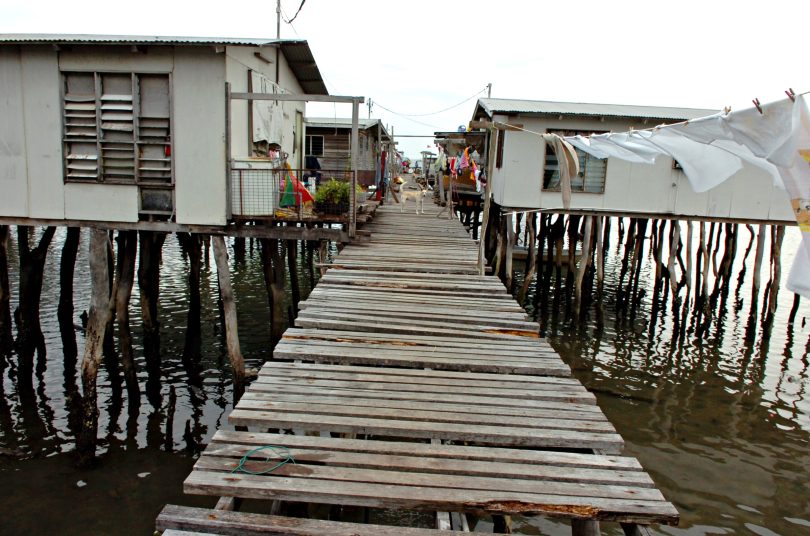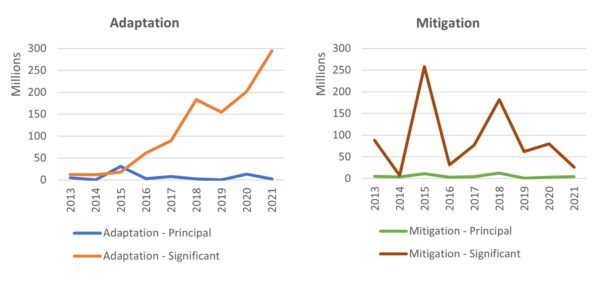There is no doubt that climate finance is urgently needed around the world. Despite this, progress has to date been slow in Papua New Guinea – the largest country in the Pacific, the biggest recipient of Australian aid, and a nation that faces significant vulnerability to climate change.
88% of the $1.87 billion (2021 USD; all figures below also 2021 USD) climate finance commitments made to PNG between 2013 and 2021 were concessional, and therefore count as part of official development assistance (ODA) to PNG. I’ll focus on concessional ‘climate aid’ in this blog, which not only forms the bulk of commitments to PNG but is also better documented and likely far more useful to PNG than other flows of climate finance.
Climate aid commitments to PNG – as recorded in the OECD’s climate-related development finance dataset between 2013 and 2021 – seem to be going up. But digging deeper shows that ‘significant’ commitments (where climate objectives are stated but aren’t the activity’s fundamental driver) are booming, while ‘principal’ commitments (in which climate objectives are fundamental in an activity’s design or motivation) are at a standstill, leaving in doubt just how much of these commitments are truly focused on helping PNG tackle climate change.
PNG receives the most climate aid in the Pacific on aggregate. Around $1.65 billion of concessional commitments were made to PNG from 2013 to 2021. The next largest climate aid recipients in the Pacific were Vanuatu and Solomon Islands, which received close to $780 million and $658 million respectively.
Per capita climate aid commitments to PNG are however the smallest in the Pacific, mirroring the situation for aid more generally. A Papua New Guinean in 2021 would have been promised just $166 of climate aid on a per capita basis for the period between 2013 and 2021, compared to around $19,202 or $9,773 for every person in Tuvalu or Nauru at the other end of the spectrum (Figure 1).
Figure 1: Commitments of climate aid and ODA, per capita (2021 USD, cumulative 2013-21)
Climate aid commitments to PNG – both in general and for adaptation purposes – appear to have been growing over the last decade or so, but remain lumpy and irregular across years. As the left panel of Figure 2 shows, Australia was the largest donor of climate aid to PNG for the period 2013 to 2021 as a whole, but others including Japan and the EU have played relatively prominent roles too. Climate aid for adaptation has also grown to make up the vast majority (over 80%) of flows recorded by the OECD in 2021 (Figure 2, right panel).
Figure 2: Climate aid commitments to PNG (left panel: total in 2021 USD; right panel: adaptation as share of total)
Note: climate-related commitments by multilateral development banks (constituting just under 9% of all climate aid commitments to PNG) are omitted from Figure 2 (right panel) and Figure 3 as they are labelled as ‘climate components’ rather than ‘principal’ or ‘significant’ for adaptation or mitigation objectives in the OECD dataset.
These gains have however been driven almost entirely by commitments that have a ‘significant’ rather than ‘principal’ climate objective. As Figure 3 shows, ‘significant’ climate aid commitments to PNG have risen very quickly. Meanwhile, ‘principal’ commitments have flatlined for most of the last decade. Commitments for ‘significant’ rather than ‘principal’ adaptation aid have been growing particularly rapidly.
Figure 3: Principal and significant climate aid commitments to PNG (2021 USD)
At best, the explosion in the number of ‘significant’ commitments suggests that PNG’s climate concerns are being integrated, or ‘mainstreamed’, into other aid to the country. At worst, it could signal that these activities, which may have gone on anyway, are being rebadged to include climate and therefore satisfy providers’ own targets and goals around climate action rather than PNG’s.
Several examples exist of aid projects in PNG that have been categorised as having a ‘significant’ climate objective, despite seeming to be unrelated to climate at first glance. For instance, the entire value of a Japan International Cooperation Agency loan supporting the redevelopment of Nadzab Airport in Lae (around $250 million as reported in the OECD’s Creditor Reporting System (CRS), using CRS project identification numbers 2015003070 and 2015003069) is listed as a climate aid commitment with a significant mitigation objective in the OECD climate finance database.
The same is true for other projects, such as the Australian Development Research Awards 2012 – Mining for Development Theme (CRS project identification number 2013000998) and Justice Services Stability for Development (CRS project identification number 2019003610a); the entire values of these projects as reported by the OECD CRS are also counted as having ‘significant’ mitigation and adaptation objectives respectively in the OECD climate finance database.
It’s difficult to assess whether the entirety (or even majority) of these ‘significant’ projects should count as climate aid for PNG without further description of exactly what the funds were put towards. If only some portion of the funding for ‘significant’ projects like these goes towards climate objectives, actual commitments of climate aid to PNG could be lower than the amounts suggested by the OECD database. Indeed, Australia estimates the share of ‘significant’ projects that count as climate finance more generally as 30% by default for its UNFCCC reporting if no other information is available, as my colleague Terence Wood has previously written about in detail.
The upshot is that despite the rise in headline numbers, it’s hard to tell whether climate aid to PNG is genuinely increasing without more transparent reporting. PNG’s experience is an important reminder to donors that the tension between achieving climate and other key development objectives isn’t going anywhere soon, and making real progress on climate finance is harder than it is on paper – especially if more aid (climate or otherwise) is not forthcoming. Australia in particular should take heed, given its outsized role in providing both aid and climate finance to PNG and the direction set out in its new international development policy.
Disclosure
This research was undertaken with the support of the ANU-UPNG Partnership, an initiative of the PNG-Australia Partnership, funded by the Department of Foreign Affairs and Trade. The views are those of the author only.





Hi Alyssa! Thank you for sharing the insightful article.
Just out of curiosity, I checked how the redevelopment of Nadzab Airport would contribute to climate change mitigation. It relates to a potential reduction of the emission of CO2, but I am not sure whether we should categorize this project as “climate-related development finance”. It is not a main objective at all.
According to the report published by JICA, “this project allows international aviation companies to reduce fuel loaded in their aircrafts by selecting
Nadzab Airport as an alternative airport to PMIA, thereby improving fuel efficiency and reducing CO2. Since emissions vary according to aviation companies and aircrafts used, calculating the quantitative effects of emission reduction is difficult. However, this project will likely make a significant contribution to mitigating climate change by reducing emissions together with the use of Japanese technologies”
You can check the report from:
https://www2.jica.go.jp/en/evaluation/pdf/2015_PN-P11_1_f.pdf
Hi Hiroshi, thanks for your comment and the additional info – that’s useful to know how the case has been made for the Nadzab Airport loan/project being climate-related. Better reporting in the data to reflect the level of climate-specificity would definitely help make the picture clearer!
Thank you Hiroshi,
That is very helpful to know. It is worth noting, I think, that the main argument made for the emergency alternate runway in Munda in Solomon Islands, was that reduced fuel load would lower the costs of flights, and thereby reduce prices. This would increase demand for flights to Solomons, and so more planes would fly, bringing more tourists.
I never really brought the argument in Solomons, but it does seem plausible that less emergency fuel carried will lead to cheaper tickets. And that this will lead to greater demand and perhaps more flights.
In other words, I’m skeptical that the runway upgrade will actually lead to lower emissions in PNG.
It seems to me that if donors are reduced to claiming this type of work as climate finance they aren’t really that serious about the issue.
Thank you though for your comments, and particularly for the link to the document. It is great to know more about the project.
Terence